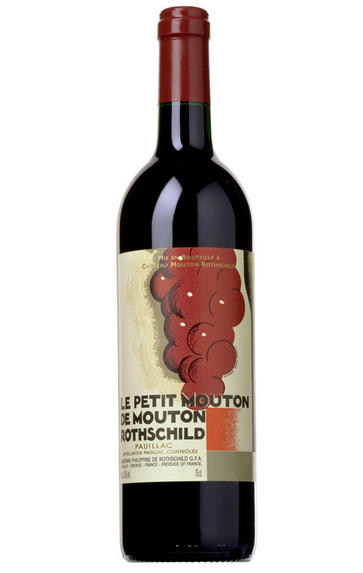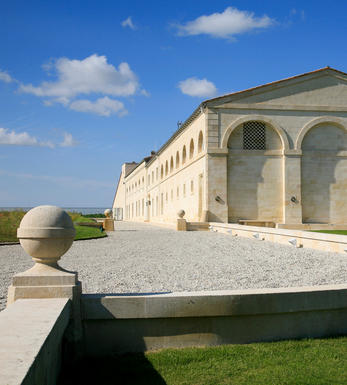
2021 Le Petit Mouton de Mouton Rothschild, Pauillac, Bordeaux

Critics reviews
Representing 40% of the total volume, a little more than usual, the 2021 Le Petit-Mouton, is aged in 50% new oak. A very Cabernet nose with conspicuous graphite scents infusing the black fruit, a little Earl Grey in the background. The palate is medium-bodied with a fleshy opening, not amazingly complex but well balanced with fine tannins and just a pinch of black pepper on the finish. Classic in style, it should give 15-20 years of drinking pleasure.
Drink 2025 - 2040
Neal Martin, Vinous.com (May 2022)
Beautifully rich and ripe, with sweet black cherry and raspberry fruits, and soft tannins that are earthy and supple. This is an excellent Petit Mouton that delivers consistency in an inconsistent year, managing to exert a gentle pressure of grilled oak without pushing too hard - one of the best 2nd wines of the year. 50% new oak. 40% Petit Mouton, harvest September 25 until October 6. The first vintage where it was Jean-Emmauel Danjoy from beginning to end, after Philippe Dhalluin retirmement. No frost impacting the yield here, and no significant impact from mildew.
Drink 2025 - 2038
Jane Anson, JaneAnson.com (May 2022)
Dark-fruit and chocolate notes. Medium-bodied with supple fruit and plush tannins on entry. Reasonably generous palate, the acidity cutting through on the finish giving bite and freshness. Low key but looking to give pleasure.
Drink 2027 - 2038
James Lawther MW, JancisRobinson.com (May 2022)
Since Mouton-Rothschild itself this year derives exclusively from the two plateaus that always make up the core of the blend, the 2021 Le Petit Mouton benefits from the inclusion of parcels that often make it into the grand vin. Exhibiting aromas of crème de cassis, mint, cigar wrapper, violets and espresso roast, it's medium to full-bodied, deep and fleshy, with a rich core of fruit, powdery tannins, succulent acids and a persistent finish. Characterful and beautifully made, I wonder if I'm being a little severe with my score?
William Kelley, Wine Advocate (April 2022)
A well-framed Petit Mouton with a tight core of black fruit and bitter-chocolate and graphite notes. Firm, fine-tannin structure. Mineral and classic with a classy finish. Punchy. 77% Cabernet Sauvignon, 19.5% Merlot, 3% Cabernet Franc and 0.5% Petit Verdot.
James Suckling, JamesSuckling.com (May 2022)
About this WINE

Château Mouton Rothschild
Classified as a First Growth, Château Mouton Rothschild has a long and storied history; wine has been made here since Roman times. The property spans 82 hectares of vines in Pauillac, planted with the classic varieties of the region, Cabernet Sauvignon being predominant.
The estate has been in the Baron Philippe de Rothschild family since 1853, but it wasn’t until the arrival of Baron Philippe de Rothschild in 1922 that its fortunes were transformed. Baron Philippe was a dynamic figure who revolutionised the estate and was the first to introduce château-bottling in 1924. He also introduced the concept of commissioning an artist to design each new vintage’s label. Some of the most notable contributors include Salvador Dalí, Henry Moore, Marc Chagall, Francis Bacon, Lucian Freud, Anish Kapoor and Peter Doig.
His daughter Baroness Philippine continued to help raise the estate to new heights with numerous endeavours, including the inauguration of a new vat house in 2013. Today, her three children, Camille and Philippe Sereys de Rothschild and Julien de Beaumarchais de Rothschild, continue the efforts of their predecessors.
Following the retirement in 2020 of Philippe Dhalluin, the winemaking team is now headed up by Jean-Emmanuel Danjoy. With his team, he oversees over 83 hectares of vines, planted with Cabernet Sauvignon (78%), Merlot (18%), Cabernet Franc (3%), and Petit Verdot (1%). The average age of the vines is around 50 years.

Pauillac
Pauillac is the aristocrat of the Médoc boasting boasting 75 percent of the region’s First Growths and with Grand Cru Classés representing 84 percent of Pauillac's production.
For a small town, surrounded by so many familiar and regal names, Pauillac imparts a slightly seedy impression. There are no grand hotels or restaurants – with the honourable exception of the establishments owned by Jean-Michel Cazes – rather a small port and yacht harbour, and a dominant petrochemical plant.
Yet outside the town, , there is arguably the greatest concentration of fabulous vineyards throughout all Bordeaux, including three of the five First Growths. Bordering St Estèphe to the north and St Julien to the south, Pauillac has fine, deep gravel soils with important iron and marl deposits, and a subtle, softly-rolling landscape, cut by a series of small streams running into the Gironde. The vineyards are located on two gravel-rich plateaux, one to the northwest of the town of Pauillac and the other to the south, with the vines reaching a greater depth than anywhere else in the Médoc.
Pauillac's first growths each have their own unique characteristics; Lafite Rothschild, tucked in the northern part of Pauillac on the St Estèphe border, produces Pauillac's most aromatically complex and subtly-flavoured wine. Mouton Rothschild's vineyards lie on a well-drained gravel ridge and - with its high percentage of Cabernet Sauvignon - can produce (in its best years) Pauillac's most decadently rich, fleshy and exotic wine.
Latour, arguably Bordeaux's most consistent First Growth, is located in southern Pauillac next to St Julien. Its soil is gravel-rich with superb drainage, and Latour's vines penetrate as far as five metres into the soil. It produces perhaps the most long-lived wines of the Médoc.
Recommended Châteaux
Ch. Lafite-Rothschild, Ch. Latour, Ch. Mouton-Rothschild, Ch. Pichon-Longueville Baron, Ch. Pichon Longueville Comtesse de Lalande, Ch. Lynch-Bages, Ch. Grand-Puy-Lacoste, Ch, Pontet-Canet, Les Forts de Latour, Ch. Haut-Batailley, Ch. Batailley, Ch. Haut-Bages Libéral.

Cabernet Sauvignon Blend
Cabernet Sauvignon lends itself particularly well in blends with Merlot. This is actually the archetypal Bordeaux blend, though in different proportions in the sub-regions and sometimes topped up with Cabernet Franc, Malbec, and Petit Verdot.
In the Médoc and Graves the percentage of Cabernet Sauvignon in the blend can range from 95% (Mouton-Rothschild) to as low as 40%. It is particularly suited to the dry, warm, free- draining, gravel-rich soils and is responsible for the redolent cassis characteristics as well as the depth of colour, tannic structure and pronounced acidity of Médoc wines. However 100% Cabernet Sauvignon wines can be slightly hollow-tasting in the middle palate and Merlot with its generous, fleshy fruit flavours acts as a perfect foil by filling in this cavity.
In St-Emilion and Pomerol, the blends are Merlot dominated as Cabernet Sauvignon can struggle to ripen there - when it is included, it adds structure and body to the wine. Sassicaia is the most famous Bordeaux blend in Italy and has spawned many imitations, whereby the blend is now firmly established in the New World and particularly in California and Australia.


Buying options
Add to wishlist
Description
Cabernet Sauvignon 77%, Merlot 19.5%, Cabernet Franc 3%, and Petit Verdot 0.5%
This is Jean-Emmanuel Danjoy’s first solo vintage here after Philippe Dhalluin’s retirement. The proportion of Cabernet Sauvignon is up again; there’s more of an architectural feel than usual. The grand vin had a much stricter selection, so some of its historic parcels are now in this blend. This feels very Cabernet-driven, with notes of lead pencil contributing to a sturdy, spicy bouquet. The tannins are certainly ripe, adding a sense of restraint. This will become quite an interesting wine, presenting a different facet than usual, although it’s not one to be kept very long-term.
Drink 2025 - 2035
Our score: 17/20
Berry Bros. & Rudd
wine at a glance
Delivery and quality guarantee